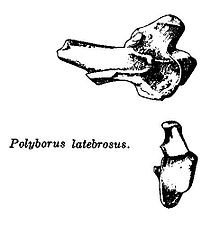The Bahaman caracara (Caracara creightoni), also known as Creighton's caracara,[1] is an extinct bird of prey. It is known only from a few fossils discovered in the Bahamas and Cuba.[2] Caracara creightoni was a scavenger and opportunistic species instead of a predator like its sister extant species (C. plancus). It lived during the late Pleistocene to the beginning of the Holocene era.
| Bahaman caracara Temporal range: Quaternary
| |
|---|---|
| Scientific classification | |
| Domain: | Eukaryota |
| Kingdom: | Animalia |
| Phylum: | Chordata |
| Class: | Aves |
| Order: | Falconiformes |
| Family: | Falconidae |
| Genus: | Caracara |
| Species: | †C. creightoni
|
| Binomial name | |
| †Caracara creightoni Brodkorb, 1959
| |
| Synonyms | |
| |

C. creightoni stood 58 cm tall, was short-winged and likely a poor flier.[2] This species went extinct as a result of humans arriving on its home islands and wiping out the bird's prey species.[1] A 2,500 year old C. creightoni femur from an Abaco Islands blue hole yielded a nearly complete mitochondrial genome.[3] The DNA shows that the species was closely related to the crested caracara. The two species last shared a common ancestor between 1.2 and 0.4 million years ago, during the Pleistocene.
References edit
- ^ a b "Extinct Caribbean bird yields DNA after 2,500 years in watery grave". phys.org. Retrieved 2019-08-20.
- ^ a b Tumas, Alejandro; Hobbs, Amanda (August 2010), Todhunter, Andrew, ed., "Blue Holes of the Bahamas" in "Deep Dark Secrets", National Geographic 218 (2): insert.
- ^ Oswald, Jessica A.; Allen, Julia M.; Witt, Kelsey E.; Folk, Ryan A.; Albury, Nancy A.; Steadman, David W.; Guralnick, Robert P. (2019-11-01). "Ancient DNA from a 2,500-year-old Caribbean fossil places an extinct bird (Caracara creightoni) in a phylogenetic context". Molecular Phylogenetics and Evolution. 140: 106576. doi:10.1016/j.ympev.2019.106576. ISSN 1055-7903. PMID 31381968.